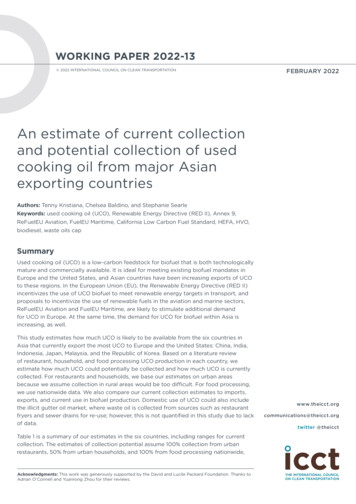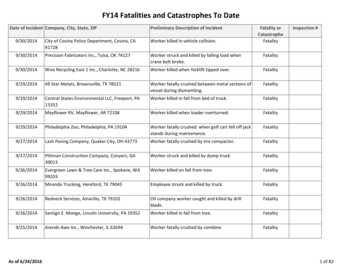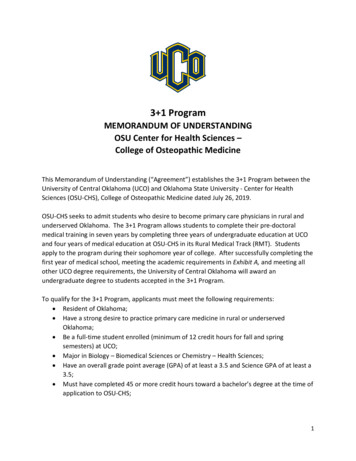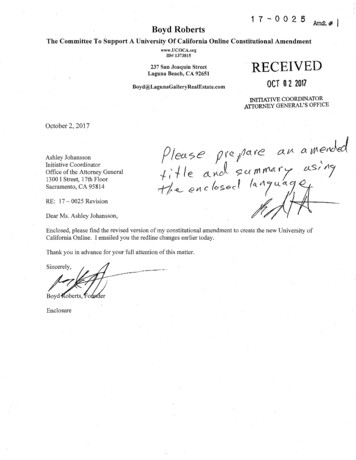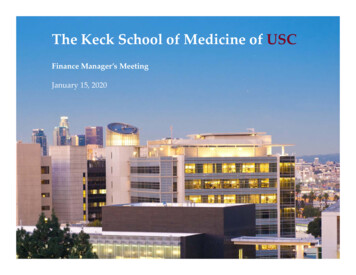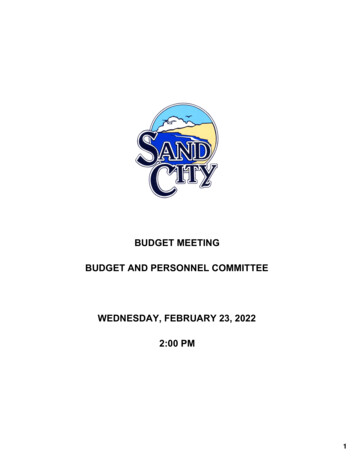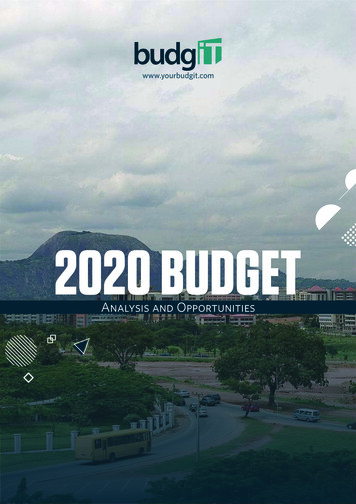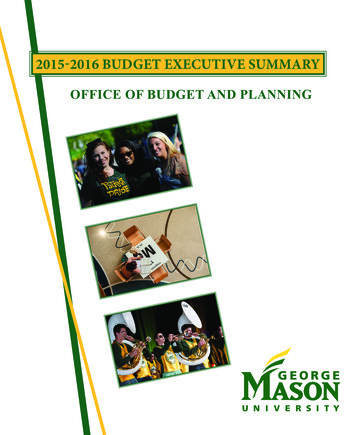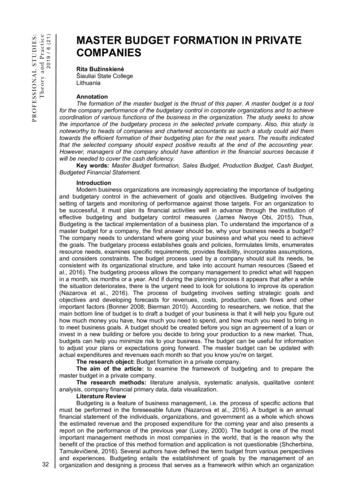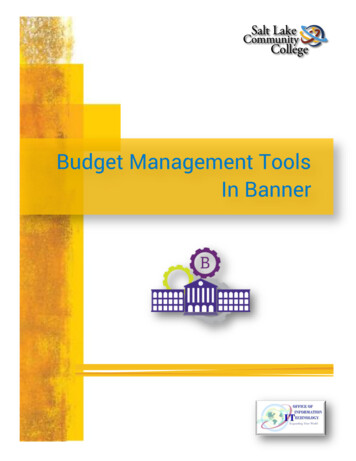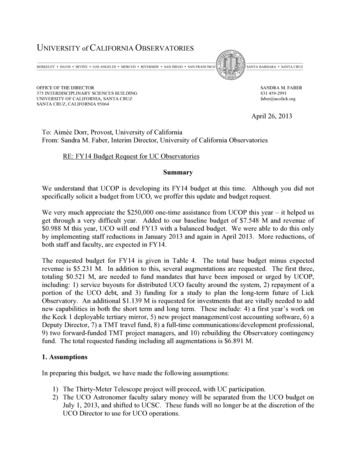
Transcription
UNIVERSITY of CALIFORNIA OBSERVATORIESBERKELEY DAVIS IRVINE LOS ANGELES MERCED RIVERSIDE SAN DIEGO SAN FRANCISCOOFFICE OF THE DIRECTOR375 INTERDISCIPLINARY SCIENCES BUILDINGUNIVERSITY OF CALIFORNIA, SANTA CRUZSANTA CRUZ, CALIFORNIA 95064SANTA BARBARA SANTA CRUZSANDRA M. FABER831 459-2991faber@ucolick.orgApril 26, 2013To: Aimée Dorr, Provost, University of CaliforniaFrom: Sandra M. Faber, Interim Director, University of California ObservatoriesRE: FY14 Budget Request for UC ObservatoriesSummaryWe understand that UCOP is developing its FY14 budget at this time. Although you did notspecifically solicit a budget from UCO, we proffer this update and budget request.We very much appreciate the 250,000 one-time assistance from UCOP this year – it helped usget through a very difficult year. Added to our baseline budget of 7.548 M and revenue of 0.988 M this year, UCO will end FY13 with a balanced budget. We were able to do this onlyby implementing staff reductions in January 2013 and again in April 2013. More reductions, ofboth staff and faculty, are expected in FY14.The requested budget for FY14 is given in Table 4. The total base budget minus expectedrevenue is 5.231 M. In addition to this, several augmentations are requested. The first three,totaling 0.521 M, are needed to fund mandates that have been imposed or urged by UCOP,including: 1) service buyouts for distributed UCO faculty around the system, 2) repayment of aportion of the UCO debt, and 3) funding for a study to plan the long-term future of LickObservatory. An additional 1.139 M is requested for investments that are vitally needed to addnew capabilities in both the short term and long term. These include: 4) a first year’s work onthe Keck 1 deployable tertiary mirror, 5) new project management/cost accounting software, 6) aDeputy Director, 7) a TMT travel fund, 8) a full-time communications/development professional,9) two forward-funded TMT project managers, and 10) rebuilding the Observatory contingencyfund. The total requested funding including all augmentations is 6.891 M.1. AssumptionsIn preparing this budget, we have made the following assumptions:1) The Thirty-Meter Telescope project will proceed, with UC participation.2) The UCO Astronomer faculty salary money will be separated from the UCO budget onJuly 1, 2013, and shifted to UCSC. These funds will no longer be at the discretion of theUCO Director to use for UCO operations.
3) The duties and responsibilities to UCO of all Astronomers who have not yet retired willremain unchanged. Thus, approximately 25% of the effort of these individuals willcontinue to be available to the Director to support UCO operations, as now.4) This is a zero-base budget in which all activities need to be justified from first principles.However, there is no maximum total for the amount of funds that can be requested.In preparing this budget, we have also paid high attention to the mandates given to UCO by theORGS-sponsored Astronomy Task Force in 2011, the External Review of UCO commissionedby ORGS in 2011, and advance advice that is shortly anticipated from the UC O/IR StrategicPlanning Committee report. These bodies have collectively advised UCO to give highest priorityto developing new instrumentation and technologies for the Keck and TMT telescopes.Finally, we conducted an analysis of Lick Observatory operations and identified further savingsthat could be achieved by adopting “spartan mode”. This mode minimizes long-terminvestments at Lick while preserving current operating capabilities. I also determined that thereare two cutting-edge projects at Lick – Shane adaptive optics on the 3-m telescope and the aboutto-be-completed Automated Planet Finder Telescope – that will each require a further five yearsof operations to bear proper scientific fruit. On top of these are the many NSF and NASA grantsthat have been awarded to individual UC astronomers who observe with Lick and who alsorequire Lick access.As a result of these determinations, I have presented to the UCO Board, and repeat here, myrecommendation that UC commit to another five years of operations at Lick Observatory, duringwhich time a study should be made to develop a long term plan for the facility. Such a study hasnow commenced in collaboration between ORGS and UCO. I have therefore also assumed thisvision for Lick Observatory and included funds for operation in spartan mode in FY14.Finally, I note that UCO’s report for the Portfolio Review Group presented eight ongoingActivities and five major new Initiatives for the Observatory. The budget priorities reflected inthis FY14 request are maximally consistent with and supportive of the goals in the PRG report aswell.The following budget justification and description of activities are organized into sections thatcorrespond to the five basic work groups of UCO. Section 2 gives a description of each workgroup’s activities and its estimated operating cost for FY14. Section 3 describes anticipatedexternal revenue from grants and gifts and uncertainties in these numbers. Section 4 describesten requested budget augmentations and their justifications. Section 5 collects these results tocompute a requested budget.2. FY14 operating budgets by work group2.1 UCSC technical groupWork of the technical group: The UCSC technical group, located at the UCSC InstrumentationLaboratories, is the heart of UCO. This is where the construction of most new instrumentsoccurs and where new technologies are developed, under the direction of UCO faculty. In FY14,2
the technical group will comprise 17 engineers and technicians and 4 research scientists. Thisgroup provides most of the manpower for the technical projects and instrument fundingproposals, and most of the external funding raised through grants and gifts goes to support thisgroup also.The distribution of technical group manpower across projects is shown in Table 1. Yellowindicates that a project is externally funded from grants or gifts, grey that it is internally fundedfrom UCOP funds. Not all external funding is secure; proposals have been submitted, but resultsare not yet known, and new sources of revenue are still being sought. Uncertainty in soft-moneyproposals is one of the biggest challenges in preparing UCO budgets, and this must be taken intoaccount in preparing the requested budget from UCOP (see Section 5).Altogether there are 23 project categories in Table 1; the notes give short descriptions. Threeprojects are connected with the Thirty-Meter Telescope (TMT), seven projects are connectedwith Keck, and the remainder are connected with Lick and UCO. The distribution of resourcesin this table follows the guidelines of the ATF, External Review, and SPC, which advise thatUCO put highest priority on developing instrumentation and technology for TMT and Keck. Wehave endeavored to do this, consistent with continuing spartan operations at Lick.We now describe these projects in more detail, sorted by observatory location:TMT projects: The largest of the TMT projects is MOBIE, which would develop into a 50 Mproject to build a first-light optical spectrograph once TMT construction begins. In FY14, thisproject will advance to preliminary design phase. UCO is also designing the TMT motor-controlsoftware and developing the critical protected-silver reflective coating that is needed for the 492primary-mirror segments.Keck projects: The largest Keck project is a proposal to the NSF for 1.5 M over four years( 369 K in FY14) to design and build a rotating tertiary mirror for the Keck 1 telescope(K1DM3). The purpose of this mirror is to enable rapid beam-switching between instruments toallow short-duration, time-critical observations. Unfortunately, prospects for funding thisproposal are poor, as we are told that NSF Astronomy may not award any new grant proposalsthis year owing to sequestration. A second large Keck project is the Keck Cosmic Web Imager, alarge spectrograph intended to take spectra of very low surface brightness objects. KCWI is ledby Caltech, but UCSC is designing and building the optically-critical spectrograph camera andwriting the motor control software. This sort of subcontracting among the Caltech and UCinstrument laboratories is typical.The third large Keck project is Next-Generation Adaptive Optics (NGAO). This is a majorupgrade that will dramatically improve Keck AO performance. The total estimated cost is 50M, and funding would start with a 20 M Mid-scale Instrumentation Grant from the NSF. Table1 allocates manpower to prepare a major proposal in FY14, assuming that the NSF willinaugurate the Mid-scale program in FY15.Lick projects: The largest Lick project is the Shane adaptive optics (AO) camera, a 2 M NSFMajor Research Infrastructure project to build next second-generation AO for the Lick 3-m3
telescope. Adaptive optics for Astronomy was pioneered at Lick, and technology developedthere by UCO was transferred to Keck, where it has been used to weigh the black hole at thecenter of the Milky Way Galaxy and image planets around other stars for the first time, amongother breakthroughs. This NSF grant funds a second-generation deformable mirror that willachieve more accurate wave front correction. All NSF funds will have been expended andfurther work in FY14 will be funded by UCOP funds. A matching grant from the MooreFoundation funds a new AO laser that will pump the sodium layer more efficiently and yield abrighter laser guide star. Together, these technologies will yield qualitatively sharper AOimages. The goal is to have a working AO system with laser and camera by spring 2014.While benefitting Lick initially, the new AO technologies developed by these projects areintended ultimately for use at Keck and TMT. They thus honor the advice given to us to givehighest priority to Keck and TMT instrumentation. This strategy of technology development andtransfer to Keck has been very successful in the past and illustrates the value of having our ownclose-at-hand Lick facilities as a test bed for new technology development.The second large project at Lick is the Automated Planet Finder telescope (APF), which is a 2.4m telescope that is designed to discover exoplanets using Doppler motions. This facility wasstarted by a 6 M grant from the US Naval Observatory and was augmented by another 4 M ofNASA and donor funds. The telescope and dome were bought from an outside vendor, while theDoppler spectrograph on the telescope was designed and built in the UCSC Instrument Labs.The telescope has had a very rocky start owing to vendor non-performance but is now coming onsky. The goal is to roboticize the telescope and commence science operations in fall 2013.Although the APF is not related to Keck or TMT instrumentation development, it is the intentionthat the money needed to operate the telescope in FY14 ( 200 K) will come from the twotelescope PIs, thus providing a welcome infusion of funds to support the technical group.The third major Lick project is a new detector for the Kast spectrograph, which is the workhorseinstrument on the Shane 3-m telescope. Mr. Kast has donated 51 K to help us install a new redCCD detector, which will greatly enhance sensitivity and photometric accuracy at redwavelengths on this heavily used instrument. This gift supports roughly a third of the totalestimated cost. Smaller Lick/UCO projects include repairs and maintenance for Lick operations,improvements to the Lick CCD controller software, remote observing support, NSF-mandatedLick data archive, etc. Rounding out the table is manpower allocated to writing proposals inFY14 to support work in FY15. All of these latter projects are mostly or entirely internallyfunded from UCOP funds.Structure and funding of the technical group: The manpower chart in Table 1 illustrates the basicchallenge facing any astronomy technical group: many skills are needed to build astronomicalinstrumentation, and multiple skills are needed in each instrument. The analogy is a car, whichneeds an engine, wheels, tires, brakes, etc., to run. If you lose a single one of these experts, youdon’t build a car. The number of employees in the UCSC technical group declined from 31.5FTE in 2004 to 23 FTE in FY13 and will be reduced to 20.5 FTE in FY14. The group is now soslim that it is impossible to trim further without losing essential skills. Doing so would meancancelling projects, which would actually worsen the budget by reducing external revenue. Thestrategy in FY14 and going forward must therefore be to adopt this minimum size and use the4
combined resources from UCOP and external funds to support it. Over time, the focus ofprojects being done by the group will move more and more to Keck and TMT, as recommendedby the UCO advisory groups.The question then arises, could the technical group become more self-supporting if additionaloutside revenue were raised? The answer here is mostly no. First, the US seems to be enteringan era in which external grant funds are going to be harder to get, not easier. Beyond that, aminimum number of persons are needed in the technical group to perform repairs, maintenance,and renewal. The number in the manpower table devoted to this is 1.9 FTE, who can only besupported by internal UCOP funds. Some capacity also needs to be allocated to proposalwriting, for which we have allocated 2.8 FTE next year (0.3 FTE for NGAO and 2.5 FTE forother proposals). Hence, nearly 5 out of 17 FTE are not eligible for external support, regardlessof external funding, and enough proposals have been submitted to more than fund the remaining11 FTE. Still, it would be good to have yet more proposals submitted in order to combatrejections, and a strategy to incentivize proposal writing by distributed UCO faculty isenvisioned next year.We close by noting that Table 1 contains a large number of small projects. This has been thetrend in recent years as money for building major new Keck optical instruments has dried up, tobe replaced by upgrades. Table 1 shows that we are competing effectively for those upgrades,but the new mode of funding means more paperwork per dollar and more work for the businessoffice staff. This has increased our overall cost of doing business.Technical group operating budget: The operating budget for the technical group is summarizedin Table 2, which compares FY13 actuals to FY14 projections. (We will be happy to augmentthe information there with salary and benefit data for individual staff members upon request.)The estimated operating budget for the technical group in FY14 is 3.124 M. This is down from 3.264 M in FY13, despite salary and benefits increases, by virtue of a net reduction of 1.00FTE.2.2 Lick Observatory staffWork of the Lick Observatory staff: The Lick Observatory staff operates four science telescopesat Mount Hamilton: the workhorse Shane 3-m reflector, the Nickel 1-m reflector, the CoudéAuxiliary Telescope on the 3-m, and the new Automated Planet Finder 2.4-m reflector. To this isadded the historic 36-inch Great Refractor dating from 1888. Like the technical group, the Lickgroup needs to have a wide variety of skills, including knowledge of telescope operations andobserving; telescope, instrument, and dome repairs; software expertise; training for newobservers; maintenance of documentation and instruction manuals; facilities maintenance;monitoring the water system and other utilities; fire and public safety; and planning and staffingthe numerous student, public, and fund-raising events, such as the Summer Visitors Program andthe Music of the Spheres concerts that are put on 10 weekends each summer. Altogether 30,000visitors visit Mount Hamilton annually, which are hosted by the Lick staff.Structure and funding of the Lick staff: Lick Observatory operations were the subject of intensebudget scrutiny last year, and the current staffing plan for FY14 is the smallest possible plan that5
will operate the Shane 3-m telescope seven nights a week. The biggest cut from FY13 is thereduction from four Shane telescope operators to three; fewer operators would mean closing theShane two nights a week, which we have determined would disrupt time-critical observationsand produce scheduling chaos. (Note: we anticipate rough waters in negotiating this change withthe union regarding a dramatic change in work schedules for the telescope operators.) We alsoplan to close for a month over the Christmas holidays, when weather is poor, and make a numberof smaller service reductions and funding shifts that in total will save 0.309 M on UCOP funds.The total mountain staff of 7.30 FTE on UCOP funds, 5.00 FTE on UCSC maintenance funds,and 1.30 FTE on gift funds is roughly half the size of the staff at Palomar, which operates thesame number of telescopes.Lick operations support systemwide UC astronomers and as such are funded mainly by UCOPwith roughly 0.133 M coming from public programs. The possibility of charging a nominal feefor telescope time on NASA and NSF grants is being explored. We are also actively seekingoutside revenue from telescope rentals, corporate sponsorships, gifts and donations, and othersources.Lick Observatory operating budget: The operating budget for Lick Observatory is summarized inTable 2, which compares FY13 actuals to FY14 projections (salary and benefits data forindividuals are available on request). The estimated operating budget for Lick in FY14 is 0.728M. The above staffing cuts and other budget strategies have reduced UCOP funds by 0.309 Mcompared to FY13.2.3 Business and administrative support staff:Work of the business and administrative staff: The business and administrative staff of UCOhandle many traditional tasks compared to other UCSC staff at both the departmental anddivisional organizational levels. They also are responsible for complex tasks that are uniquewithin the university setting. The Assistant Director for Administration and Business Servicesmanages all administrative and business functions for UCO. She manages the budget (comprisedof a broad range of complicated fund sources and activities), oversees business operations toensure a high level of support and compliance, forecasts future expenditures, and supports theDirector with special data analyses, planning activities, and solutions for unique, complex issues.The Director’s Executive Assistant manages the Director’s calendar, travel, and correspondence,is the gateway voice of the Observatory on phone and by email, manages the personnel processfor academic employees (research scientists), manages the Observatory webpage andcommunications, schedules all student tours of Lick Observatory, and supports the Friends ofLick donor group.The business operations staff of 2.00 FTE conduct procurement, direct payment processing, Licklodging scheduling and billing, and equipment management. The human resources staff of 1.75FTE are in charge of academic and staff personnel management, payroll and time reporting, staffrecruiting, performance management, merit reviews, and labor relations. A single FTE incontracts and grants prepares budgets, coordinates with campus Contracts and Grants forsubmittals, manages the federal reporting system, and manages the grant closeout process. FourFTE in financial and facilities management manage all aspects of UCO operations accounts,6
perform space planning and facilities coordination, prepare and manage special contracts withvendors and users of Lick land and facilities, perform contract analysis and compliance, preparecost estimates and financial reporting for instrumentation projects, provide historical data onprojects, liaise with the UC Real Estate office and Legal Counsel, etc.FY14 will bring several changes to the workload of this group. Transfer of UCO faculty fromUCOP to UCSC will mean that their science research grants, academic hiring on those grants,and their own academic personnel evaluations will be administered by UCSC, reducing theworkload for UCO by approximately 1.00 FTE. Commensurate resources will be transferredfrom UCO to UCSC to cover this support. We will be eliminating the Business OperationsManager/Sr Buyer position when we adopt the campus purchasing system in July 2013.Moreover, an external review of business office operations in June 2013 is expected torecommend a major overhaul of database tools and project management/tracking software. Newlicenses, staff training, and possibly the services of a consultant will be needed. Thus, FY14promises to be a very busy year for the business office staff, after which some streamlining isanticipated.Structure and funding of the business and administrative staff: The total business andadministrative staff numbers 11.6 FTE, reduced by 1.45 FTE from FY13. This being aninfrastructure function, the group is supported mainly by UCOP funds though approximately 0.105 M, or 9% is raised from grants.Business and administrative operating budget: The operating budget for the business andadministrative staff is summarized in Table 2, which compares FY13 actuals to FY14projections. The estimated operating budget for this group in FY14 is 1.158 M. Staffing cutsand other strategies have reduced funding by 0.101 M compared to FY13.2.4 UCLA IR LabWork of the UCLA IR Lab: The prime work of the UCLA IR Lab has been designing andbuilding infrared instruments for Keck Observatory. All operating IR instruments at Keck wereled or had major components supplied by UCLA. Two Keck-related proposals have beensubmitted for FY14: a proposal to NASA to upgrade the NIRSPEC detector, and a proposal toNSF to upgrade the OSIRIS detector. In addition, if TMT goes ahead, the IR Lab will functionas the lead institution for IRIS, which is a first-light infrared adaptive optics imager andspectrograph that will cost of order 30 M. Like MOBIE, IRIS enters the preliminary designphase in FY14.Structure and funding of the UCLA IR Lab: The UCLA IR lab currently has three 9-monthUCLA faculty and 8 technical engineers and technicians. This is their minimum sustainableroster; staff expands when work allows, as will happen when TMT takes off. The total operatingbudget in core mode is 900 K. Historically, UCO has provided 300-375 K, which pays threekey permanent staff members: systems administrator, administrative assistant, and lab manager,summer salary to the faculty, and a stipend to the Director, Ian Mclean. Additional funds go fortravel and operational support. The lab has typically relied on soft-money funding for theremainder of their budget, with a mixture of Keck-funded projects and outside projects for other7
observatories. Since soft money is variable, having UCO funds for foundational infrastructurehas been crucial to seeing them through lean times.UCLA IR Lab operating budget: In FY14, the IR Lab faces another year of uncertain externalfunds. TMT/IRIS will bring 900 K, but not until spring quarter. The two detector projects maynot be funded. The only secure source of funds at this time is an outside project calledFLITECAM, which will bring in 300 K. The Director has submitted a well justified budget for 340 K, which we would like to fund. This increase of 13% over the FY13 amount is consistentwith the priority stated in the ATF and PRG reports of ensuring a secure future for the IR Lab.2.5 UCO facultyWork of the UCO faculty: The UCO faculty are currently located on two campuses, UCSC andUCLA. If the augmentation for distributed UC faculty is granted (Section 4), in FY14 there willalso be UCO-affiliated faculty on other campuses. The responsibilities and duties of UCOfaculty are as follows:1) Setting overall goals and policies for UCO: Input from internal UCO groups, advisorycommittees such as the UCOAC, and external groups is synthesized by UCO faculty to developoverall directions and strategies for UCO.2) Representing UC O/IR interests within UC and to external astronomical communities: Thisinvolves staffing and managing relations with external groups such as the Keck Science SteeringCommittee, the Keck CARA Board, the TMT Board and TMT Science Advisory Committee, theOffice of Research and Graduate Studies at UCOP, UC Academic Senate committees such asUCORP, and the newly created UCO Board.3) Providing policies, direction, and high-level oversight for the UCO work groups, including theUCO faculty themselves: This entails developing work plans that follow from high-levelinstitutional priorities and providing oversight and high-level management through each workgroup staff leader. Faculty also confer with group leaders to resolve schedule and staffing issues,write staff performance evaluations, and advise the Director on salaries and promotions of staff.4) Overseeing and managing policies and procedures for ensuring effective access to Keck andLick by UC observers: This includes running the time-assignment process for UC nights at Keckand Lick, scheduling the telescopes, making sure (through oversight committees at Keck anddirect management at Lick) that the instrumentation and operation of both observatories meetsUC needs, and overseeing the creation of data archives and data-reduction pipelines.5) Initiating and executing the construction of astronomical instrumentation for Keck, TMT, andLick: This involves acting as Principle Investigator for projects, setting the performancerequirements for each project, writing the necessary proposals, leading the conceptual design,assembling the necessary funding and other resources, interfacing with vendors, and leading staffin the detailed design, construction, and installation and commissioning at the telescope. Typicalprojects have budgets of 1-15 M and involve teams of 10-25 engineers, scientists, and8
technicians (who may be located at Caltech and Keck as well as at UCSC and UCLA). FutureTMT projects will be two-to-three times as large.6) Developing the astronomical technologies of the future, through research, computation, andlaboratory experimentation: This work in detail looks much like item (5) but is a separateactivity that is crucial to the long-term strategy of keeping UC O/IR astronomy at the cuttingedge.7) Initiating, overseeing, preparing, and participating in education, outreach, and communicationactivities: This involves communicating the work and achievements of UCO to the public, toUC, and to the state of California. Communication channels include the UCO and Lick websites,the UCO annual report, Lick Newsletter, and UC reports such as the Portofolio Review Groupreport and presentations to the UCO Board. UCO faculty support visitor programs at LickObservatory and partner with educational institutions to improve student learning, teachertraining, and public understanding of science. Much of this can be done by staff, but faculty areneeded to initiate programs, raise resources, and provide scientific oversight.8) Initiating, overseeing, and participating in fund-raising and development programs for UCO/IR astronomy: This work is similar to the activities in item (7) above. As true there, much ofthis work can be done by staff, but faculty are needed to develop overall strategies, providescientific guidance, and find and cultivate donors.9) Supporting and promoting graduate, undergraduate, and postdoctoral teaching and trainingand carrying out forefront research. The teaching and training program is led by faculty butinvolves close collaboration with staff, particularly in instrumentation and technology.10) Assisting the Director on special projects, such as the building committee for the design of anew Instrument Laboratories building at UCSC.In FY14, UCO faculty will be carrying out all of the above tasks. Lack of space prevents detailson all of them, but we highlight especially: Supervision of the UCSC technical programs in Table 1 and the instrument programs atUCLA. Leading major reviews and entry into the preliminary design phases of the two TMT first-lightinstruments, IRIS and MOBIE. Organizing the science team for Next-Generation Adaptive Optics at Keck ( 50 M) andpreparing proposals to donors and federal agencies. Implementing strategies and policies recommended by UCO’s Strategic Planning Committeethis spring, particularly the design and installation of distributed UCO faculty positions aroundthe system.9
Initiating the study to prepare the long term plan for Lick Observatory. Chairing and supporting the work of the Building Committee to design the new UCOInstrument Laboratories facility at UCSC. Stepped-up participation to create the new TMT scientific community, which will involveextra outreach and travel to our partners in Canada, Japan, China, and India.Structure and funding of the UCO faculty: This discussion of UCO faculty manpower does notinclude the Director, as this person works 100% on a wide variety of tasks and should beconsidered an administrative appointee going forward. Currently there are 10.6 UCO facultyFTE at UCSC, occupied by 13 individuals. If retirements take place as scheduled, fourindividuals will retire in FY14, leaving 9 individuals occupying 7.4 FTE. This 30% drop in asingle year represents a serious loss of experience and expertise. To rebuild, we are requestingfunds to hire a Deputy Director and to create the equivalent of three additional UCO facultyaffiliate positions distributed around the system (see Section 4).Altogether, the 9 faculty left at UCSC, 3 at UCLA, and 3 newly created distributed faculty willamount to at total of 15 faculty engaged in the UCO mission in FY14. Detailed assignments toindividuals have not yet been made, but the aggregate workload for this group is shown in Table3. The units are people (not FTE), where 1.0 person means one faculty member devoting 25% ofhis/her time in service to UCO. The assignments are rough and have not yet been vetted by theUCOAC but are illustrative. Instrumentation PIs are assumed to be in two stages, the initialphase and early construction, wh
9) two forward-funded TMT project managers, and 10) rebuilding the Observatory contingency fund. The total requested funding including all augmentations is 6.891 M. 1. Assumptions In preparing this budget, we have made the following assumptions: 1) The Thirty-Meter Telescope project will proceed, with UC participation.
